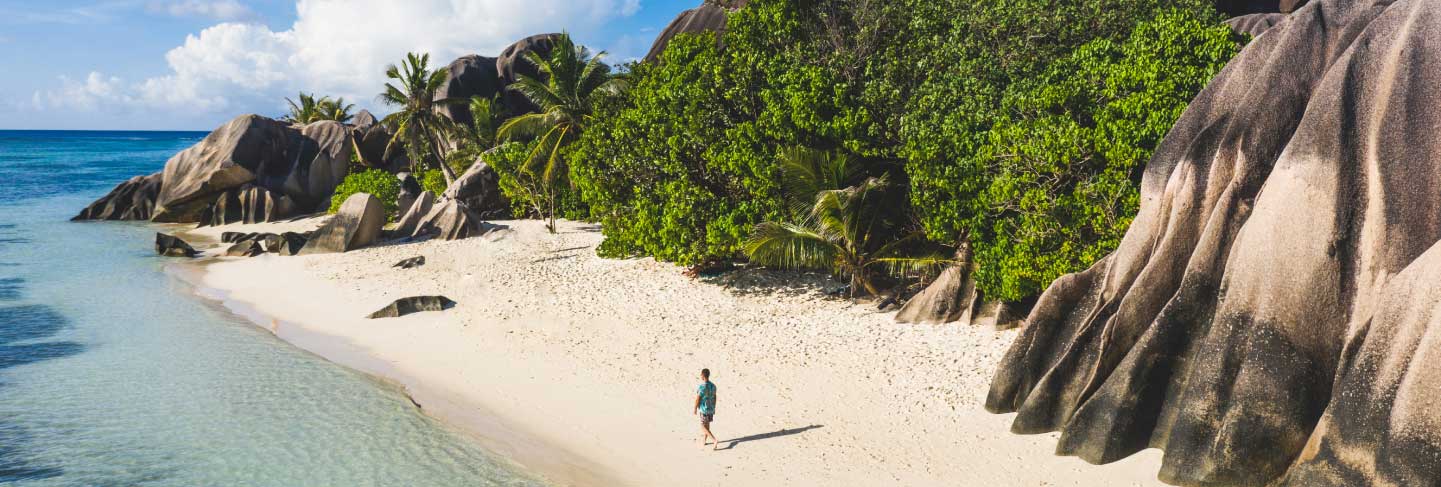How to get involved in mangrove conservation on Curieuse Island
Tasneem Johnson-Dollie
Posted: April 8, 2020
Mangrove forests are a link between land and sea, and we can’t do without this essential ecosystem. That’s why we’ve taken to counting mangrove trees on Curieuse Island, to contribute to mangrove conservation.
Over the last 50 years, the world has seen one-third of its mangrove forests disappear, mostly due to human activity. But humans have also been making a positive impact in environmental conservation. Just take a look at the mangrove tree survey that GVI staff and volunteers recently completed on Curieuse Island.
Getting involved in mangrove surveys
Mangrove surveys are a biannual event for volunteers on Curieuse Island.
Every February and August, our staff train volunteers to identify and count mangrove trees in Curieuse’s mangrove forests.
It all starts with a trip down a seaside boardwalk that winds its way from the beach, into a mangrove forest.
Imagine walking down this boardwalk, with the wooden boards echoing your every step, and the sounds of the sea sloshing through the wind-rustled trees.
You’ve been through training on base. Now you’ll test your tree-spotting skill out in the mangrove forest.
You focus your eyes, and the green haze of trees starts to separate into distinct floral structures.
Suddenly you spot a white mangrove. You can see its rounded crown – made up of thick, leathery, olive-green leaves.
You turn your head to the left, and a satisfied smile streaks across your face.
You’ve spotted the difference between that tree and the black mangrove tree – with its conical crown made up of apple-green or yellow leaves that are crowded at the ends of branches.
Suddenly you realise that your training has paid off, and you can now start contributing to the conservation of these mangrove trees through survey work.
Count mangrove trees on Curieuse Island
But this is a forest with thousands of trees.
So first things first, you take out your tape measure, and plot out a 10-metre quadrant.
You’ll make eight of these quadrants, and record the type, age and number of mangrove trees in each. It’s a better approach than trying to slog through the entire forest, counting every tree as you go.
A couple of hours later, you’ll have enough data to make a scientific estimate of the number of trees in the mangrove forest.
Guess what? You’ve just contributed to the conservation of an ecosystem on Curieuse Island.
Why should we contribute to mangrove conservation?
Mangrove forests are one of the most productive ecosystems on Earth, with the World Wildlife Fund (WWF) stating that mangrove forests provide around 186 million dollars worth of resources every year.
Further reading: What’s so curious about Curieuse?
These resources stem from the:
- coastal protection mangrove forests provide
- tourism opportunities generated by the diversity of life inhabiting mangrove forests.
So why are these important ecosystems in need of protection?
Original video: Your Earth Is Blue: Mangroves by NOAA Sanctuaries licensed under CC BY-ND 4.0
Well, there are many reasons why mangrove forests are dwindling:
- Climate change and pollution are changing the environments in which mangrove trees live.
- Overfishing is changing the ecosystems that keep mangroves alive.
- The presence of dams and irrigation systems changes the amount of water that reaches mangrove forests from rivers, which can cause oversalination or dehydration of mangrove forests.
- The destruction of barrier reefs – the land’s first line of defence against the sea – means that harsher currents and stronger waves can affect the fine sediment in which mangrove trees grow.
- Overharvesting and clearing of mangrove trees by farmers and developers also contributes to the loss of mangrove forests. See how below.
Original video: Mangroves for the Future Indonesia by Indonesia Nature Film Society licenced under CC BY-ND 4.0
One way to make up for the loss of mangrove trees is to contribute to their conservation., Volunteering to count mangrove trees in Curieuse is the perfect way to start. Navigate to our Facebook page to see more about our programs on Curieuse Island.
Go to GVI Online if you’re excited to learn more about biological survey techniques, and you want to make a start in mangrove conservation before you even arrive on Curieuse Island.
Tasneem Johnson-Dollie is an intern at the GVI Writing Academy. The Writing Academy is a skills-development program that pairs development editors with budding travel writers. Learn more about the program here.
By Tasneem Johnson-Dollie





